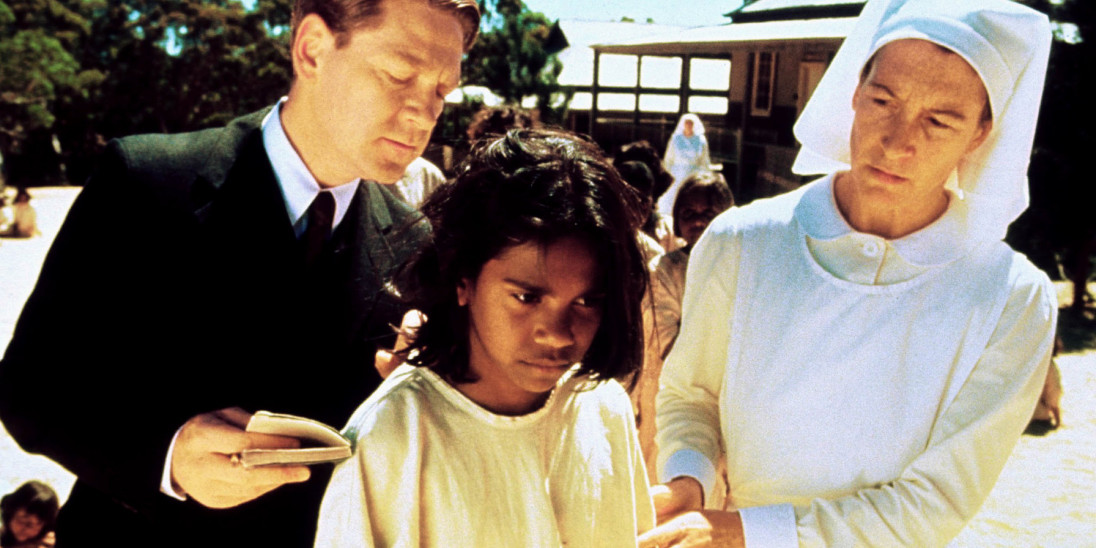By Chlotrudis Independent Film Society
Rating: 5 cats
Director: Phillip Noyce
Starring: David Gulpilil | Everlyn Sampi | Kenneth Brannagh | Laura Monaghan | Tianna Sansbury

Country: australia
Year: 2002
Running time: 94
IMDB: http://us.imdb.com/Details?0252444
Elllen says: “Thanks to Michael getting up at a very early hour to procure tickets at the Toronto Film Festival, I was able to see this fabulous film based on the true story of three aboriginal girls who were taken from their aboriginal family and plopped into a very British ‘orphanage.’ Under the leadership of their very determined older sister, they decide to walk across the country to return to their mother by following the rabbit-proof fence.”
Michael says: “Phillip Noyce is a big budget Hollywood director who grew tired of the Tom Clancy franchise and returned to Australia to make RABBIT-PROOF FENCE. Based on fact and set in 1931, this is the story of Molly Craig, who at age 14 was taken from her mother along with her younger sister and cousin, and relocated to a settlement where half-caste (half Aboriginal/half white) children were integrated into white society (usually as housekeepers). This outrageous practice (which continued until 1970) was spearheaded by Mr. Neville (Kenneth Branagh) who was appointed guardian to all half-caste children in the country. After being brought to the settlement, 1500 miles north of Jigalong, where her mother resides, Molly, Daisy and cousing Gracie, ranging from ages 14 – 8, decide to escape and walk back to their home following the rabbit-proof fence that runs along the spine of Australia.
“Noyce does an amazing directing job, faced with the challenges of non-professional child actors, and a difficult environment. The children are remarkable, their serious, dark faces lending a gravity to every scene. Noyce uses the environment masterfully, playing with the light in the dessert to make the fleeing children appear as gaunt, skeletal stick figures and amplifying the night sounds of insects as the girls flee through the forest. The tension hits a high note early on and is maintained throughout the entire film.
“There are many wonderful scenes, but a powerful exchange occurs toward the end of the film between Molly and Daisy’s mother and grandmother, and Constable Riggs, who is charged with returning the girls to the settlement. The real-life postscript to the film will astound you.
“My biggest shock? I couldn’t believe that those who saw RABBIT-PROOF FENCE and got it nominated for Best Movie and Best Director left it out of the Best Adapted Screenplay category! This was such a flacid year for Adapted Screenplays that this adaptation of Molly’s daughter’s book should have been included. I know I would have nominated it.
“Noyce tells a simple story beautifully, sleekly, and passionately. And he does so without alarming, melodramatic tricks, but by smart, powerful storytelling. I think this might be in my Top 10!” 5 cats
Peg says: “Director Phillip Noyce (PATRIOT GAMES) returns to his native continent with this based-in-fact film that has already caused considerable controversy Down Under. In 1931, the ‘White Australia Policy’ decreed that ‘half-caste’ Aboriginal children fathered by whites would be forcibly removed from their homes and trained for domestic servitude. Many of these children were fathered by the men who built and maintained the rabbit-proof fence that bisects Australia. The heroines of Noyces story, Molly, Daisy, and Gracie, are taken from their mothers in Jigalong and sent to a settlement 1200 miles away but with plucky Molly (Everlyn Sampi in an impressive debut) leading the way, the girls escape, traveling by night and foraging for food as they search for and follow the fence that will lead them back home.
“Pieced together from letters and police reports, the straightforward narrative refuses to demonize the governments actions. Kenneth Branagh is understated as the official overseeing the investigation; WALKABOUT’s David Gulpilil is superb as a silent tracker who may be torn between duty and racial loyalty. Peter Gabriels evocative score and Christopher Doyle’s gorgeous photography enliven this glimpse into Australias dark imperialistic past.”
